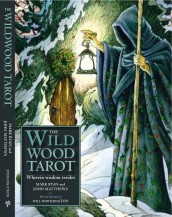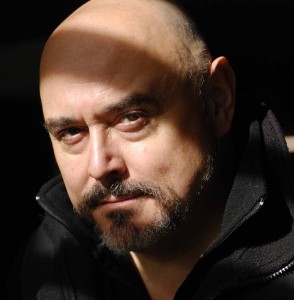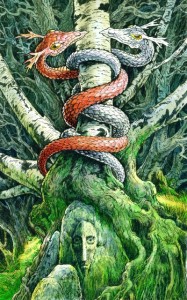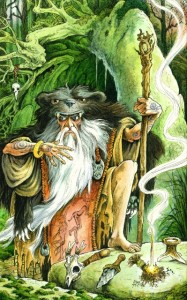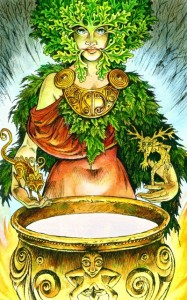Mark Ryan does all sorts of things. On stage, he was in the original London production of EVITA, first as Magaldi, then as Che and more recently, he toured with Eric Idle in ERIC IDLE EXPLOITS MONTY PYTHON. On television, he starred as the Merry Man Nasir in three seasons of HTV’s ROBIN OF SHERWOOD (the first two seasons are now out on Blu-ray from Acorn). On film, he’s been the voice of Bumblebee and Jetfire in the TRANSFORMERS movies.
As a comic book writer, he created THE PILGRIM with Mike Grell. As a songwriter, he’s working on a musical version of WUTHERING HEIGHTS. And if that’s not enough, Ryan has designed and written the companion book and tarot cards for THE WILDWOOD TAROT deck. He’ll be appearing at Dark Delicacies bookstore in Burbank tonight (Wednesday) to sign it.
For more information on the signing – CLICK HERE.
ASSIGNMENT X: You first designed another tarot card deck, THE GREENWOOD TAROT, back in the ‘90s, correct?
MARK RYAN: The original idea started probably about ’91, ’92. [GREENWOOD deck artist] Chesca Potter and I laid out the [Rider-Waite tarot] Major Arcana cards on the floor of my home in a circle in a Wheel of the Year pattern and we were surprised that they actually fit in quite a comfortable way. I called [Arthurian scholar] John Mathews. He said, “What a great idea, I wish I’d done it.” [laughs] And that’s how we knew we were on to something. Once we’d developed it further, we went to Harper Collins. I wrote the book [that accompanies the GREENWOOD deck] in the first person because I just wanted to write it as the journey of discovery that basically I’ve gone through. It. was published in ’95.
AX: The companion books for both GREENWOOD and WILDWOOD explain how to interpret the cards?
RYAN: There are a lot of influences working within Tarot, but the magic is in your head. Whether you believe that the universe has a consciousness of its own – some people believe that – whether you believe there is some divine entity or however you perceive that to be, there’s a part of our human conscious and subconscious minds that is able to interact with that. And so my framework of belief is that, particularly in Tarot, there are three major elements interacting when you read the cards. One is the artwork itself, which is Jungian archetypal, in the sense that the twenty-two major cards represent a type of person, a personality trait, or a universally accepted human state, whether it’s happy, sad, whatever. The Major Arcana are a map of the fractals and facets of the energies that play upon the human psyche. That’s why when you look at the artwork of the cards, subconsciously, they’re having an effect on you, whether you are aware of it or not. That’s why meditation is a useful tool with these things, because that usually brings out some issue that you probably weren’t aware of in your conscious mind.
The next thing is the concept of meaningful chance or synchronicity. I don’t believe in the concept that everything is fated. I believe that there are possibilities and probabilities. It’s highly probable that I will never dance the Black Swan [laughs]. It’s probable I’m going to get up tomorrow morning and go, “Oh, I’d better do something useful.” By pushing a possibility or a probability, if you move forward in a positive and creative way, you’re much more likely to get a positive result, as opposed to just staying there and waiting for something to happen. So when you are shuffling and laying out the cards, I believe you’re actually choosing the cards that are going to come out in your reading. I don’t believe it’s random. I believe it appears random, but I believe on some level, you are subconsciously arranging the cards in a way that is going to answer the question, or bring insight into the question that you are asking.
Throughout the seventeen years that I’ve been doing this, I can honestly say I have never, in all of the readings I’ve done, had an irrelevant reading. I’ve never had a reading that had nothing to do with the question. The third thing is the Grail question, asking the question. I believe that by asking a question of the universe, you are creating a vacuum into which the universe has no option other than to bring an answer. How clearly you define that question and with how much conviction you’re asking it and why you’re asking it will define the answer that you get. So it’s very important that you really are clear about the question you’re asking, and understand that if you ask a question, you will get an answer. This may not be the answer that you expect or you want, but it will be a true reflection of the question that you’ve asked.
AX: Having already designed one tarot deck, how did you wind up doing THE WILDWOOD TAROT?
RYAN: THE GREENWOOD TAROT went out of print. I’m very happy and very proud of the fact that I had a book out there called THE GREENWOOD TAROT that apparently got a cult success. Over the years, people would come back to me and say, “Do you have the rights back and can we re-publish?” The [text] rights reverted back to myself and the artwork rights reverted to Chesca. I was approached by a couple of companies to republish and I’d thought about updating the book. So there were attempts made to track down Chesca. She basically didn’t want to be involved. From what I understand, she’s safe and well and wants to be left alone to live her life. I sincerely wish her the best in the world.
So I [had] the concept of the original book and the Wheel of the Year system that we’d worked on, and I thought [a new version] would be a worthwhile thing to do, because it would make the concept more accessible. And then John Mathews approached me. “Are you interested in working with me on restructuring the book?” I like working with John. We’ve done various projects together, including working on two King Arthur films [FIRST KNIGHT and KING ARTHUR], and his enthusiasm is amazing. GREENWOOD was originally called THE WILDWOOD TAROT. At the time, [GREENWOOD publisher] Harper Collins thought “Wildwood” would be too raunchy for their New Age market. [laughs] I can’t explain why anybody would think a thorn bush or an oak tree might be a little bit too raunchy. But anyway, they thought “Wildwood” was a little bit too wild. And so I was very excited when [the editors at Edward Sard] said, “We’d like to go back to the original concept called THE WILDWOOD TAROT and redo it with you and John doing it.” They obviously had a very high regard for [artist] Will Worthington. When we looked at Will’s work and the samples that he brought in for his cards, we went, “This is great.” And there we were, Three Musketeers.
AX: What was John Mathews’ contribution to WILDWOOD?
RYAN: I like looking at history, but I’m not an art historian. John, being a scholar and a real historian and understanding all these things, he’s a great sounding board to put it into the legendary mystical meets the historical meets the factual, and so his contribution was not only being involved with how we re-jigged the Wheel of the Year a little bit to a more traditional cycle. We kind of set the cycle on its side for THE GREENWOOD TAROT and used it a different way, and I think John’s suggestion was that we put things back in the original order. He also contributed to the explanations of the cards. To be clear, the WILDWOOD TAROT book is not a reprinting of THE GREENWOOD TAROT book. We’ve added a lot of new material and obviously, it’s fifteen years later, so we can talk a lot about the additions to human knowledge that have broadened human perceptions of nature and where we are in the universe and our relationship to the planet that we live on. So John’s contribution was priceless. With Will, we sat down, we had one big meeting, we talked about the style and some of the descriptions for the cards and Will just got it. He just got it. He’s absolutely nailed it with this pack.
AX: To be specific, for instance, with the Four of Arrows, “Rest,” did you say, “We want a man lying facedown with a butterfly and a branch and a brown sky,” or did you just say, “It’s four arrows”?
RYAN: We wrote a detailed art brief for each card. This was a figure facedown, resting. I’m one of those people, I will push myself sometimes until I fall down. If you are a driven individual, you sometimes have to be reminded of the concept that your brain and body need rest so you can rejuvenate the system, so you can come back the next day and think, “Okay, that’s what the butterfly represents.” Sometimes that’s what the arrows represent. Sometimes you’ve just got to be pinned down to the ground [laughs].
AX: Did you give as much detail as, “The butterfly should be yellow with a little bit of orange …”
RYAN: No. Will has done lots of things extraordinarily well, particularly with the Major Arcana. The Balance card is one of the most beautiful Balance cards I think I’ve ever seen in any pack. Three of Stones, Creativity, is interesting – that’s a beautiful card. Some of them we had to work on a little bit. The Blasted Oak [WILDWOOD’s version of the Tower card] and the Guardian, those usually throw people. Some of the concepts are a little difficult to access until we explain it. Pole Star, he did a fantastic job with that. Moon on Water, beautiful card, absolutely amazing piece of artwork. Will’s artwork is so powerful. He’s done such an amazing job, and the detail – fantastic, powerful, primal artwork.
AX: Is the artwork meant to evoke any specific historical period?
RYAN: No. One of the things I wanted with this, which Will has achieved brilliantly, was to make the artwork more accessible to a mainstream audience. And by that, I mean you can pick up one of these cards, and [the characters] look like people. I mean, some of them look like people with animal legs and some of them look like talking skeletons, but for the most part, the artwork is immediately accessible. There’s no era. It was one of the things again that we wanted to keep, the timelessness of it, because the primordial concepts that we’re talking about go back to man’s first steps on the face of the planet. The drive of the pack, which must drive the art, is that it’s going back to man’s first conceptualization of art. We put types of readings in there, including the Bow Spread, which I personally use because I have had pretty amazing results with the Bow Spread, but you can do any reading you like, any shape. The magic is working through your brain, your mind, your conscious, your subconscious, through the cards, and presenting you with that.
AX: Apparently THE WILDWOOD TAROT is selling really well …
RYAN: The deck is doing phenomenally well. I am sincerely humbled by the fact that it is doing so well. For a few weeks, it was number one on Amazon’s Tarot listings for the best-selling deck, ahead of Rider-Waite, and it was number one on Amazon’s most wished-for list months before it was published.
AX: Some people believe one should only receive a tarot deck as a gift, rather than as a purchase for one’s self …
RYAN: I’m not a traditionalist in this way at all with any of this. If you want to buy this as a gift for somebody, by all means, gift away, and if you want to go out and purchase it for yourself, go on and purchase it for yourself. I don’t think there is any stigma to have gone out and bought this for yourself. Some purists even trim off the boarders and card names so they can resonate directly with the imagery without our personal interpretations. That’s fine with me.
AX: And you’re doing a signing tonight for WILDWOOD TAROT at Dark Delicacies …
RYAN: I’ve been doing a lot of appearances to support all of the projects I’m involved in. I like talking to people who have followed TRANSFORMERS or ROBIN OF SHERWOOD or tarot fans or whatever they’re interested in, I like getting that feedback. It’s very humbling that people spend their time absorbed by the magic. The real magic for me is taking that intangible idea, the concept, taking it from this little firing of synapses in your brain that you can’t even grasp what it means, being able to focus it through your consciousness, through language, through your hands into the typewriter and making that live. Creating artwork, a book, whatever, in this reality, so that little spark ends up being something that will affect people as a practical reality in our lives. That to me is the definition of magic. This [WILDWOOD TAROT] is very accessible, it’s so striking, it’s so powerful. You look at it and go, “I get this, I understand what this means,” and not be too lost in the esoteric subtleties of it. There are plenty of esoteric subtleties, but the card speaks to you immediately. THE WILDWOOD TAROT, I hope, talks to people, it communicates with people immediately, and if it reaches a wider audience, I’m very happy with it. So far I think it’s doing its job rather well.
Related Posts:




